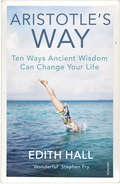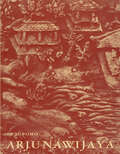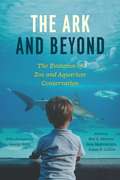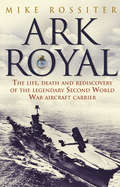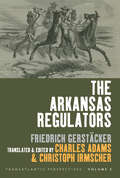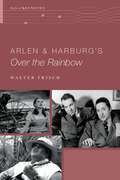- Table View
- List View
Aristotle’s Theory of Practical Cognition: 3d. edition
by Takatsura AndoI have much pleasure in writing a preface to Mr. Takatura Ando's book on Aristotle. Apart from his intrinsic importance, as one of the three or four greatest of all philosophers, Aristotle is important on having given for many centuries the greatest influence in moulding the thought of European countries. The language difficulty has no doubt prevented him from exercising very much influence on Japanese thought, and I welcome very warmly to hear that Mr. Ando is about to have his book printed in Japan. I hope it will be widely circulated, as it must certain ly deserve that. W. D. Ross AUTHOR'S FOREWORD In publishing this book, I cannot prohibit myself of reminding the days and nights when it was written. In that era of worldwide madness, Aristotle's philosophy was the only refuge wherein my depressed mind could come to life. It was written bit by bit under all desperate circum stances throughout the war time. My heart was set on the completion of this work while the fate allowed me to live. It was nearly carried out by the end of the war. Having no hope of survival, I buried my manu script in the earth, without however any expectance of a better lot for it.
Aristotle’s Theory of the Syllogism: A Logico-Philological Study of Book A of the Prior Analytics (Synthese Library #16)
by G. PatzigThe present book is the English version of a monograph 'Die aristotelische Syllogistik', which first appeared ten years ago in the series of Abhand 1 lungen edited by the Academy of Sciences in Gottingen. In the preface to the English edition, I would first like to express my indebtedness to Mr. J. Barnes, now fellow of Oriel College, Oxford. He not only translated what must have been a difficult text with exemplary precision and ingenuity, but followed critically every argument and check ed every reference. While translating it, he has improved the book. Of those changes which I have made on Mr. Barnes' suggestion I note only the more important ones on pages 4, 12, 24sq, 32, 39, 6lsq, and 158. Since the second edition of the German text appeared in 1963 some further reviews have been published, or come to my notice, which I have 2 been able to make use of in improving the text of this new edition. I must mention here especially the detailed critical discussions of my results and arguments published by Professor W. Wieland in the Philosophische Rundschau 14 (1966), 1-27 and by Professor E. Scheibe in Gnomon 39 (1967), 454-64. Both scholars, while agreeing with the main drift and method of my interpretation, criticise some of my results and disagree with some of my arguments. It would not be possible to discuss these technical matters here with the necessary thoroughness.
Aristotle’s Way: How Ancient Wisdom Can Change Your Life
by Edith Hall‘Wonderful and timely … Hugely recommended’ STEPHEN FRYWhat do you and an ancient philosopher have in common? It turns out much more than you might think…Aristotle was an extraordinary thinker, perhaps the greatest in history. Yet he was preoccupied by an ordinary question: how to be happy. His deepest belief was that we can all be happy in a meaningful, sustained way – and he led by example.In this handbook to his timeless teachings, Professor Edith Hall shows how ancient thinking is precisely what we need today, even if you don’t know your Odyssey from your Iliad. In ten practical lessons we come to understand more about our own characters and how to make good decisions. We learn how to do well in an interview, how to choose a partner and life-long friends, and how to face death or bereavement.Life deals the same challenges – in Ancient Greece or the modern world. Aristotle’s way is not to apply rules – it’s about engaging with the texture of existence, and striding purposefully towards a life well lived.This is advice that won’t go out of fashion.
Aristoxenus of Tarentum: Texts and Discussion
by Carl HuffmanAristoxenus of Tarentum was reported to have been bitterly disappointed when Theophrastus was chosen instead of him to succeed Aristotle as the head of the Peripatetic School. He had a truly phenomenal output of some 453 volumes, most of which survive only in fragments. He was the most famous music theorist in antiquity and came to be referred to simply as "the musician." In addition, he was a founder of Greek biography and wrote the life histories of Pythagoras, Archytas, Socrates, and Plato among others. This volume includes eleven selections, which are almost evenly divided between his work in music theory and biography. There is a chapter on his general biographical method as well as chapters on his specific treatments of the Pythagoreans, Socrates, and Plato. There are chapters evaluating the extent to which Aristoxenus was a historian of music, his account of music therapy, his views on musical "character," the use of instruments and empiricism in his harmonic theory, and his relation to the "Neoclassical" Greek composers of the fourth century. This volume includes: "Did Aristoxenus Write Musical History?, " Andrew Barker; "Instruments and Empiricism in Aristoxenus' Elementa harmonica," David Creese; "Aristoxenus and Musical Ethos," Eleonora Rocconi; "Aristoxenus and Music Therapy: Fr. 26 Wehrli Within the Tradition on Music and Catharsis," Antonella Provenza; "Aristoxenus and the "Neoclassicists," Timothy Power; "Apollonius on Theophrastus on Aristoxenus," William W. Fortenbaugh; "Aristoxenus' Biographical Method," Stefan Schorn; "Aristoxenus and the Pythagoreans," Leonid Zhmud; "Aristoxenus' Life of Socrates," Carl A. Huffman; "Aristoxenus' Life of Plato," John Dillon; and "Aristoxenus and the Early Academy," Andrew Barker. Spanning close to three full decades, Transaction's Rutgers University Studies in Classical Humanities Series continues to pioneer in the field of classical studies.
Aristoxenus of Tarentum: Texts and Discussion
by Carl HuffmanAristoxenus of Tarentum was reported to have been bitterly disappointed when Theophrastus was chosen instead of him to succeed Aristotle as the head of the Peripatetic School. He had a truly phenomenal output of some 453 volumes, most of which survive only in fragments. He was the most famous music theorist in antiquity and came to be referred to simply as "the musician." In addition, he was a founder of Greek biography and wrote the life histories of Pythagoras, Archytas, Socrates, and Plato among others. This volume includes eleven selections, which are almost evenly divided between his work in music theory and biography. There is a chapter on his general biographical method as well as chapters on his specific treatments of the Pythagoreans, Socrates, and Plato. There are chapters evaluating the extent to which Aristoxenus was a historian of music, his account of music therapy, his views on musical "character," the use of instruments and empiricism in his harmonic theory, and his relation to the "Neoclassical" Greek composers of the fourth century. This volume includes: "Did Aristoxenus Write Musical History?, " Andrew Barker; "Instruments and Empiricism in Aristoxenus' Elementa harmonica," David Creese; "Aristoxenus and Musical Ethos," Eleonora Rocconi; "Aristoxenus and Music Therapy: Fr. 26 Wehrli Within the Tradition on Music and Catharsis," Antonella Provenza; "Aristoxenus and the "Neoclassicists," Timothy Power; "Apollonius on Theophrastus on Aristoxenus," William W. Fortenbaugh; "Aristoxenus' Biographical Method," Stefan Schorn; "Aristoxenus and the Pythagoreans," Leonid Zhmud; "Aristoxenus' Life of Socrates," Carl A. Huffman; "Aristoxenus' Life of Plato," John Dillon; and "Aristoxenus and the Early Academy," Andrew Barker. Spanning close to three full decades, Transaction's Rutgers University Studies in Classical Humanities Series continues to pioneer in the field of classical studies.
Arithmetic
by Paul LockhartPaul Lockhart reveals arithmetic not as the rote manipulation of numbers but as a set of ideas that exhibit the surprising behaviors usually reserved for higher branches of mathematics. In this entertaining survey, he explores the nature of counting and different number systems—Western and non-Western—and weighs the pluses and minuses of each.
The Arithmetic of Al-Uqlīdisī: The Story of Hindu-Arabic Arithmetic as told in Kitāb al-Fuṣūl fī al-Ḥisāb al-Hindī
by A.S. SaidanThe purpose of presenting this book to the scholarly world is twofold. In the first place, I wish to provide for the English reader a translation of the earliest extant Arabic work of Hindi arithmetic. It shows this system at its earliest stages and the first steps in its development, a subject not yet well known except for readers of some Arabic publications by the present writer. This book is therefore of particular importance for students of the history of mathematical techniques. The medieval author, AI-UqHdisI, was, it seems, not noticed by bibliographers; neither was his work, which lay hardly noticed by modern scholars until 1960 when I happened to see a microfilm copy of it in the Institute of Arabic Manu scripts in Cairo. A steady labour immediately followed to make a comparative study of the text together with over twenty other texts, some of them not yet known to scholars. This pursuit resulted in (i) a doctoral degree awarded to me in 1966 by the University of Khartoum, (ii) the publication of several texts in Arabic including the text here translated, and (iii) the publication of several articles in Arabic and English on the history of arithmetic in the Middle Ages. The second purpose of this book is to make the main results of my study available to the English reader.
The Arithmetic of Infinitesimals (Sources and Studies in the History of Mathematics and Physical Sciences)
by John WallisJohn Wallis (1616-1703) was the most influential English mathematician prior to Newton. He published his most famous work, Arithmetica Infinitorum, in Latin in 1656. This book studied the quadrature of curves and systematised the analysis of Descartes and Cavelieri. Upon publication, this text immediately became the standard book on the subject and was frequently referred to by subsequent writers. This will be the first English translation of this text ever to be published.
The Arithmetica of Diophantus: A Complete Translation and Commentary (Scientific Writings from the Ancient and Medieval World)
by Jean Christianidis Jeffrey OaksThis volume offers an English translation of all ten extant books of Diophantus of Alexandria’s Arithmetica, along with a comprehensive conceptual, historical, and mathematical commentary. Before his work became the inspiration for the emerging field of number theory in the seventeenth century, Diophantus (ca. 3rd c. CE) was known primarily as an algebraist. This volume explains how his method of solving arithmetical problems agrees both conceptually and procedurally with the premodern algebra later practiced in Arabic, Latin, and European vernaculars, and how this algebra differs radically from the modern algebra initiated by François Viète and René Descartes. It also discusses other surviving traces of ancient Greek algebra and follows the influence of the Arithmetica in medieval Islam, Byzantium, and the European Renaissance down to the 1621 publication of Claude-Gaspard Bachet’s edition. After the English translation the book provides a problem-by-problem commentary explaining the solutions in a manner compatible with Diophantus’s mode of thought. The Arithmetica of Diophantus provides an invaluable resource for historians of mathematics, science, and technology, as well as those studying ancient Greek, medieval Islamic and Byzantine, and Renaissance history. In addition, the volume is also suitable for mathematicians and mathematics educators.
The Ark and Beyond: The Evolution of Zoo and Aquarium Conservation (Convening Science: Discovery at the Marine Biological Laboratory)
by Ben A. Minteer Jane Maienschein James P. CollinsScores of wild species and ecosystems around the world face a variety of human-caused threats, from habitat destruction and fragmentation to rapid climate change. But there is hope, and it, too, comes in a most human form: zoos and aquariums. Gathering a diverse, multi-institutional collection of leading zoo and aquarium scientists as well as historians, philosophers, biologists, and social scientists, The Ark and Beyond traces the history and underscores the present role of these organizations as essential conservation actors. It also offers a framework for their future course, reaffirming that if zoos and aquariums make biodiversity conservation a top priority, these institutions can play a vital role in tackling conservation challenges of global magnitude. While early menageries were anything but the centers of conservation that many zoos are today, a concern with wildlife preservation has been an integral component of the modern, professionally run zoo since the nineteenth century. From captive breeding initiatives to rewilding programs, zoos and aquariums have long been at the cutting edge of research and conservation science, sites of impressive new genetic and reproductive techniques. Today, their efforts reach even further beyond recreation, with educational programs, community-based conservation initiatives, and international, collaborative programs designed to combat species extinction and protect habitats at a range of scales. Addressing related topics as diverse as zoo animal welfare, species reintroductions, amphibian extinctions, and whether zoos can truly be “wild,” this book explores the whole range of research and conservation practices that spring from zoos and aquariums while emphasizing the historical, scientific, and ethical traditions that shape these efforts. Also featuring an inspiring foreword by the late George Rabb, president emeritus of the Chicago Zoological Society / Brookfield Zoo, The Ark and Beyond illuminates these institutions’ growing significance to the preservation of global biodiversity in this century.
The Ark and Beyond: The Evolution of Zoo and Aquarium Conservation (Convening Science: Discovery at the Marine Biological Laboratory)
by Ben A. Minteer Jane Maienschein James P. CollinsScores of wild species and ecosystems around the world face a variety of human-caused threats, from habitat destruction and fragmentation to rapid climate change. But there is hope, and it, too, comes in a most human form: zoos and aquariums. Gathering a diverse, multi-institutional collection of leading zoo and aquarium scientists as well as historians, philosophers, biologists, and social scientists, The Ark and Beyond traces the history and underscores the present role of these organizations as essential conservation actors. It also offers a framework for their future course, reaffirming that if zoos and aquariums make biodiversity conservation a top priority, these institutions can play a vital role in tackling conservation challenges of global magnitude. While early menageries were anything but the centers of conservation that many zoos are today, a concern with wildlife preservation has been an integral component of the modern, professionally run zoo since the nineteenth century. From captive breeding initiatives to rewilding programs, zoos and aquariums have long been at the cutting edge of research and conservation science, sites of impressive new genetic and reproductive techniques. Today, their efforts reach even further beyond recreation, with educational programs, community-based conservation initiatives, and international, collaborative programs designed to combat species extinction and protect habitats at a range of scales. Addressing related topics as diverse as zoo animal welfare, species reintroductions, amphibian extinctions, and whether zoos can truly be “wild,” this book explores the whole range of research and conservation practices that spring from zoos and aquariums while emphasizing the historical, scientific, and ethical traditions that shape these efforts. Also featuring an inspiring foreword by the late George Rabb, president emeritus of the Chicago Zoological Society / Brookfield Zoo, The Ark and Beyond illuminates these institutions’ growing significance to the preservation of global biodiversity in this century.
The Ark and Beyond: The Evolution of Zoo and Aquarium Conservation (Convening Science: Discovery at the Marine Biological Laboratory)
by Ben A. Minteer Jane Maienschein James P. CollinsScores of wild species and ecosystems around the world face a variety of human-caused threats, from habitat destruction and fragmentation to rapid climate change. But there is hope, and it, too, comes in a most human form: zoos and aquariums. Gathering a diverse, multi-institutional collection of leading zoo and aquarium scientists as well as historians, philosophers, biologists, and social scientists, The Ark and Beyond traces the history and underscores the present role of these organizations as essential conservation actors. It also offers a framework for their future course, reaffirming that if zoos and aquariums make biodiversity conservation a top priority, these institutions can play a vital role in tackling conservation challenges of global magnitude. While early menageries were anything but the centers of conservation that many zoos are today, a concern with wildlife preservation has been an integral component of the modern, professionally run zoo since the nineteenth century. From captive breeding initiatives to rewilding programs, zoos and aquariums have long been at the cutting edge of research and conservation science, sites of impressive new genetic and reproductive techniques. Today, their efforts reach even further beyond recreation, with educational programs, community-based conservation initiatives, and international, collaborative programs designed to combat species extinction and protect habitats at a range of scales. Addressing related topics as diverse as zoo animal welfare, species reintroductions, amphibian extinctions, and whether zoos can truly be “wild,” this book explores the whole range of research and conservation practices that spring from zoos and aquariums while emphasizing the historical, scientific, and ethical traditions that shape these efforts. Also featuring an inspiring foreword by the late George Rabb, president emeritus of the Chicago Zoological Society / Brookfield Zoo, The Ark and Beyond illuminates these institutions’ growing significance to the preservation of global biodiversity in this century.
The Ark and Beyond: The Evolution of Zoo and Aquarium Conservation (Convening Science: Discovery at the Marine Biological Laboratory)
by Ben A. Minteer Jane Maienschein James P. CollinsScores of wild species and ecosystems around the world face a variety of human-caused threats, from habitat destruction and fragmentation to rapid climate change. But there is hope, and it, too, comes in a most human form: zoos and aquariums. Gathering a diverse, multi-institutional collection of leading zoo and aquarium scientists as well as historians, philosophers, biologists, and social scientists, The Ark and Beyond traces the history and underscores the present role of these organizations as essential conservation actors. It also offers a framework for their future course, reaffirming that if zoos and aquariums make biodiversity conservation a top priority, these institutions can play a vital role in tackling conservation challenges of global magnitude. While early menageries were anything but the centers of conservation that many zoos are today, a concern with wildlife preservation has been an integral component of the modern, professionally run zoo since the nineteenth century. From captive breeding initiatives to rewilding programs, zoos and aquariums have long been at the cutting edge of research and conservation science, sites of impressive new genetic and reproductive techniques. Today, their efforts reach even further beyond recreation, with educational programs, community-based conservation initiatives, and international, collaborative programs designed to combat species extinction and protect habitats at a range of scales. Addressing related topics as diverse as zoo animal welfare, species reintroductions, amphibian extinctions, and whether zoos can truly be “wild,” this book explores the whole range of research and conservation practices that spring from zoos and aquariums while emphasizing the historical, scientific, and ethical traditions that shape these efforts. Also featuring an inspiring foreword by the late George Rabb, president emeritus of the Chicago Zoological Society / Brookfield Zoo, The Ark and Beyond illuminates these institutions’ growing significance to the preservation of global biodiversity in this century.
The Ark and Beyond: The Evolution of Zoo and Aquarium Conservation (Convening Science: Discovery at the Marine Biological Laboratory)
by Ben A. Minteer Jane Maienschein James P. CollinsScores of wild species and ecosystems around the world face a variety of human-caused threats, from habitat destruction and fragmentation to rapid climate change. But there is hope, and it, too, comes in a most human form: zoos and aquariums. Gathering a diverse, multi-institutional collection of leading zoo and aquarium scientists as well as historians, philosophers, biologists, and social scientists, The Ark and Beyond traces the history and underscores the present role of these organizations as essential conservation actors. It also offers a framework for their future course, reaffirming that if zoos and aquariums make biodiversity conservation a top priority, these institutions can play a vital role in tackling conservation challenges of global magnitude. While early menageries were anything but the centers of conservation that many zoos are today, a concern with wildlife preservation has been an integral component of the modern, professionally run zoo since the nineteenth century. From captive breeding initiatives to rewilding programs, zoos and aquariums have long been at the cutting edge of research and conservation science, sites of impressive new genetic and reproductive techniques. Today, their efforts reach even further beyond recreation, with educational programs, community-based conservation initiatives, and international, collaborative programs designed to combat species extinction and protect habitats at a range of scales. Addressing related topics as diverse as zoo animal welfare, species reintroductions, amphibian extinctions, and whether zoos can truly be “wild,” this book explores the whole range of research and conservation practices that spring from zoos and aquariums while emphasizing the historical, scientific, and ethical traditions that shape these efforts. Also featuring an inspiring foreword by the late George Rabb, president emeritus of the Chicago Zoological Society / Brookfield Zoo, The Ark and Beyond illuminates these institutions’ growing significance to the preservation of global biodiversity in this century.
The Ark and Beyond: The Evolution of Zoo and Aquarium Conservation (Convening Science: Discovery at the Marine Biological Laboratory)
Scores of wild species and ecosystems around the world face a variety of human-caused threats, from habitat destruction and fragmentation to rapid climate change. But there is hope, and it, too, comes in a most human form: zoos and aquariums. Gathering a diverse, multi-institutional collection of leading zoo and aquarium scientists as well as historians, philosophers, biologists, and social scientists, The Ark and Beyond traces the history and underscores the present role of these organizations as essential conservation actors. It also offers a framework for their future course, reaffirming that if zoos and aquariums make biodiversity conservation a top priority, these institutions can play a vital role in tackling conservation challenges of global magnitude. While early menageries were anything but the centers of conservation that many zoos are today, a concern with wildlife preservation has been an integral component of the modern, professionally run zoo since the nineteenth century. From captive breeding initiatives to rewilding programs, zoos and aquariums have long been at the cutting edge of research and conservation science, sites of impressive new genetic and reproductive techniques. Today, their efforts reach even further beyond recreation, with educational programs, community-based conservation initiatives, and international, collaborative programs designed to combat species extinction and protect habitats at a range of scales. Addressing related topics as diverse as zoo animal welfare, species reintroductions, amphibian extinctions, and whether zoos can truly be “wild,” this book explores the whole range of research and conservation practices that spring from zoos and aquariums while emphasizing the historical, scientific, and ethical traditions that shape these efforts. Also featuring an inspiring foreword by the late George Rabb, president emeritus of the Chicago Zoological Society / Brookfield Zoo, The Ark and Beyond illuminates these institutions’ growing significance to the preservation of global biodiversity in this century.
The Ark Before Noah: Decoding The Story Of The Flood
by Irving FinkelIn THE ARK BEFORE NOAH, British Museum expert Dr Irving Finkel reveals how decoding the symbols on a 4,000 year old piece of clay enable a radical new interpretation of the Noah's Ark myth. A world authority on the period, Dr Finkel's enthralling real-life detective story began with a most remarkable event at the British Museum - the arrival one day in 2008 of a single, modest-sized Babylonian cuneiform tablet - the palm-sized clay rectangles on which our ancestors created the first documents. It had been brought in by a member of the public and this particular tablet proved to be of quite extraordinary importance. Not only does it date from about 1850 BC, but it is a copy of the Babylonian Story of the Flood, a myth from ancient Mesopotamia revealing among other things, instructions for building a large boat to survive a flood. But Dr Finkel's pioneering work didn't stop there. Through another series of enthralling discoveries he has been able to decode the story of the Flood in ways which offer unanticipated revelations to readers of THE ARK BEFORE NOAH.
Ark Royal: Sailing Into Glory
by Mike RossiterIn June 1941 the Ark Royal won one of Britain's most famous naval victories. The German destroyer, Bismarck, had been ravaging the British fleet in the Atlantic. Sailing through a ferocious storm the Ark Royal tracked the Bismarck. A dozen swordfish bombers took off from her deck and pounded shell after shell into the German battleship, sending her to the ocean floor. It was a signal victory that resonated around the world. Hitler, furious at the loss of the German fleet's flagship, demanded that the Ark Royal be destroyed at whatever cost.HMS Ark Royal is one of the Royal Navy's most iconic ships. When she was launched in 1938 she was one of the most sophisticated weapons at the disposal of British military command. The aircraft carrier was the latest, and soon to be one of the most feared, developments in naval warfare. In her first two years of operation the Ark Royal survived countless attacks, and was considered one of the luckiest ships in the Navy.But her air of invincibility was to prove wishful thinking. Within one month of sinking the Bismarck, the Ark Royal too was destroyed while sailing off the coast of Gibraltar. And there she has rested, one kilometre below the surface of the Mediterranean, until her wreck was discovered by Mike Rossiter in 2004.In gripping detail, and using the testimony of survivors of the sinking and men who lived, flew and fought on the Ark Royal, Mike Rossiter tells the remarkable story of the life and legend of this most iconic of ships. Also, and for the first time, he reveals the story of the quest to discover the wreck of this naval legend.
The Arkansas Regulators (Transatlantic Perspectives #5)
by Friedrich Gerstäcker, Charles Adams and Christoph IrmscherThe Arkansas Regulators is a rousing tale of frontier adventure, first published in German in 1846, but virtually lost to English readers for well over a century. Written in the tradition of James Fenimore Cooper, but offering a much darker and more violent image of the American frontier, this was the first novel produced by Friedrich Gerstäcker, who would go on to become one of Germany’s most famous and prolific authors. A crucial piece of a nineteenth-century transatlantic literary tradition, this long-awaited translation and scholarly edition of the novel offers a startling revision of the frontier myth from a European perspective.
Arlen and Harburg's Over the Rainbow (Oxford Keynotes)
by Walter Frisch"Over the Rainbow" exploded into worldwide fame upon its performance by Judy Garland in the MGM film musical The Wizard of Oz (1939). Voted the greatest song of the twentieth century in a 2000 survey, it is a masterful, delicate balance of sophistication and child-like simplicity in which composer Harold Arlen and lyricist E. Y. "Yip" Harburg poignantly captured the hope and anxiety harbored by Dorothy's character. In Arlen and Harburg's Over the Rainbow, author Walter Frisch traces the history of this song from its inception during the development of The Wizard of Oz's screenplay, to its various reinterpretations over the course of the twentieth century. Through analysis of the song's music and lyrics, this Oxford Keynotes volume provides a close reading of the piece while examining the evolution of its meaning as it traversed widely varying cultural contexts. From its adoption as a jazz standard by generations of pianists, to its contribution to Judy Garland's role as a gay icon, to its reemergence as a chart-topping recording by Hawaiian singer Israel Kamakawiwo'ole, "Over the Rainbow" continues to engage audiences and performers alike in surprising ways. Featuring a companion website with audio and video supplements, this book leaves no path unexplored as it succeeds in capturing the extent of this song's impact on the world.
Arlen and Harburg's Over the Rainbow (Oxford Keynotes)
by Walter Frisch"Over the Rainbow" exploded into worldwide fame upon its performance by Judy Garland in the MGM film musical The Wizard of Oz (1939). Voted the greatest song of the twentieth century in a 2000 survey, it is a masterful, delicate balance of sophistication and child-like simplicity in which composer Harold Arlen and lyricist E. Y. "Yip" Harburg poignantly captured the hope and anxiety harbored by Dorothy's character. In Arlen and Harburg's Over the Rainbow, author Walter Frisch traces the history of this song from its inception during the development of The Wizard of Oz's screenplay, to its various reinterpretations over the course of the twentieth century. Through analysis of the song's music and lyrics, this Oxford Keynotes volume provides a close reading of the piece while examining the evolution of its meaning as it traversed widely varying cultural contexts. From its adoption as a jazz standard by generations of pianists, to its contribution to Judy Garland's role as a gay icon, to its reemergence as a chart-topping recording by Hawaiian singer Israel Kamakawiwo'ole, "Over the Rainbow" continues to engage audiences and performers alike in surprising ways. Featuring a companion website with audio and video supplements, this book leaves no path unexplored as it succeeds in capturing the extent of this song's impact on the world.
Aršāma and his World: Volume II: Bullae and Seals (Oxford Studies in Ancient Documents)
During the Second World War the Bodleian Library in Oxford acquired a set of Aramaic letters, eight sealings, and the two leather bags in which the sealed letters were once stored. The letters concern the affairs of Aršāma, satrap of Egypt in the later fifth century. Taken with other material associated with him (mostly in Aramaic, Demotic Egyptian, and Akkadian), they illuminate the Achaemenid world of which Aršāma was a privileged member and evoke a wide range of social, economic, cultural, organizational, and political perspectives, from multi-lingual communication, storage and disbursement of resources, and satrapal remuneration, to cross-regional ethnic movement, long-distance travel, religious practice, and iconographic projection of ideological messages. Particular highlights include a travel authorization (the only example of something implicit in numerous Persepolis documents), texts about the religious life of the Judaean garrison at Elephantine, Aršāma's magnificent seal (a masterpiece of Achaemenid glyptic, inherited from a son of Darius I), and echoes of temporary disturbances to Persian management of Egypt. But what is also impressive is the underlying sense of systematic coherence founded on and expressed in the use of formal, even formalized, written communication as a means of control. The Aršāma dossier is not alone in evoking that sense, but its size, variety, and focus upon a single individual give it a unique quality. Though this material has not been hidden from view, it has been insufficiently explored: it is the purpose of the three volumes of Aršāma and his World: The Bodleian Letters in Context to provide the fullest presentation and historical contextualization of this extraordinary cache yet attempted. Volume I presents and translates the letters alongside a detailed line-by-line commentary, while Volume II reconstructs the two seals that made the clay bullae that sealed the letters, with special attention to Aršāma's magnificent heirloom seal. Volume III comprises a series of thematic essays which further explore the administrative, economic, military, ideological, religious, and artistic environment to which Aršāma and the letters belonged.
Aršāma and his World: Volume III: Aršāma's World (Oxford Studies in Ancient Documents)
During the Second World War the Bodleian Library in Oxford acquired a set of Aramaic letters, eight sealings, and the two leather bags in which the sealed letters were once stored. The letters concern the affairs of Aršāma, satrap of Egypt in the later fifth century. Taken with other material associated with him (mostly in Aramaic, Demotic Egyptian, and Akkadian), they illuminate the Achaemenid world of which Aršāma was a privileged member and evoke a wide range of social, economic, cultural, organizational, and political perspectives, from multi-lingual communication, storage and disbursement of resources, and satrapal remuneration, to cross-regional ethnic movement, long-distance travel, religious practice, and iconographic projection of ideological messages. Particular highlights include a travel authorization (the only example of something implicit in numerous Persepolis documents), texts about the religious life of the Judaean garrison at Elephantine, Aršāma's magnificent seal (a masterpiece of Achaemenid glyptic, inherited from a son of Darius I), and echoes of temporary disturbances to Persian management of Egypt. But what is also impressive is the underlying sense of systematic coherence founded on and expressed in the use of formal, even formalized, written communication as a means of control. The Aršāma dossier is not alone in evoking that sense, but its size, variety, and focus upon a single individual give it a unique quality. Though this material has not been hidden from view, it has been insufficiently explored: it is the purpose of the three volumes of Aršāma and his World: The Bodleian Letters in Context to provide the fullest presentation and historical contextualization of this extraordinary cache yet attempted. Volume I presents and translates the letters alongside a detailed line-by-line commentary, while Volume II reconstructs the two seals that made the clay bullae that sealed the letters, with special attention to Aršāma's magnificent heirloom seal. Volume III comprises a series of thematic essays which further explore the administrative, economic, military, ideological, religious, and artistic environment to which Aršāma and the letters belonged.
Aršāma and his World: Volume I: The Bodleian Letters (Oxford Studies in Ancient Documents)
During the Second World War the Bodleian Library in Oxford acquired a set of Aramaic letters, eight sealings, and the two leather bags in which the sealed letters were once stored. The letters concern the affairs of Aršāma, satrap of Egypt in the later fifth century. Taken with other material associated with him (mostly in Aramaic, Demotic Egyptian, and Akkadian), they illuminate the Achaemenid world of which Aršāma was a privileged member and evoke a wide range of social, economic, cultural, organizational, and political perspectives, from multi-lingual communication, storage and disbursement of resources, and satrapal remuneration, to cross-regional ethnic movement, long-distance travel, religious practice, and iconographic projection of ideological messages. Particular highlights include a travel authorization (the only example of something implicit in numerous Persepolis documents), texts about the religious life of the Judaean garrison at Elephantine, Aršāma's magnificent seal (a masterpiece of Achaemenid glyptic, inherited from a son of Darius I), and echoes of temporary disturbances to Persian management of Egypt. But what is also impressive is the underlying sense of systematic coherence founded on and expressed in the use of formal, even formalized, written communication as a means of control. The Aršāma dossier is not alone in evoking that sense, but its size, variety, and focus upon a single individual give it a unique quality. Though this material has not been hidden from view, it has been insufficiently explored: it is the purpose of the three volumes of Aršāma and his World: The Bodleian Letters in Context to provide the fullest presentation and historical contextualization of this extraordinary cache yet attempted. Volume I presents and translates the letters alongside a detailed line-by-line commentary, while Volume II reconstructs the two seals that made the clay bullae that sealed the letters, with special attention to Aršāma's magnificent heirloom seal. Volume III comprises a series of thematic essays which further explore the administrative, economic, military, ideological, religious, and artistic environment to which Aršāma and the letters belonged.



